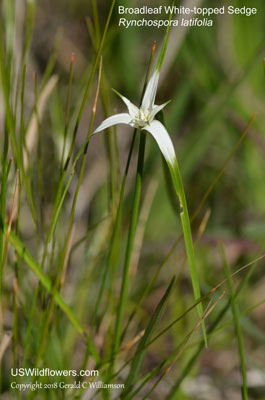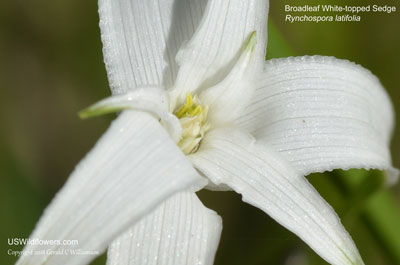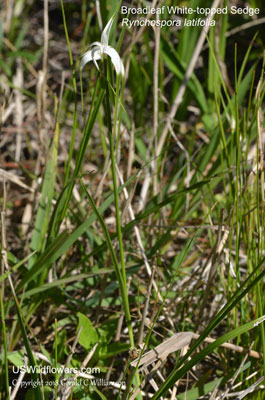Wildflowers of the United States | |||||||||||||
| |||||||||||||
Rhynchospora latifolia - Broadleaf White-topped Sedge, Sandswamp Whitetop Sedge. | Rhynchospora (Beaksedge) is a large genus of sedges with over 250 member species worldwide, and nearly 70 in North America. Identification of sedges to the species can be very difficult unless you are truly an expert, and I'm certainly not. Fortunately the white-topped Beaksedges are very limited - only 3 in the United States, so that clears the field a lot. These white-topped species are in subgenus Diplostylae, section Dichromena. All species in that section were until fairly recently classified in the separate genus Dichromena. The white-topped species are R. floridensis, found only in the southern half of Florida, R. colorata, and R. latifolia. Both of the latter two species are found throughout most of Florida as well as in several other southeastern states. These photographs were taken outside the range of R. floridensis, so these are either R. latifolia or R. colorata. Among the differences between the two species are the basal width of the longest involucral bracts, with R. latifolia usually being at least 5 mm wide, and R. colorata being less than 5 mm wide. The white portion of the R. latifolia lowest bract is also longer than that of R. colorata at 22-55mm vs 9-25mm. Unfortunately I did not measure the bracts, so I must rely on other characteristics, and I get mixed results. R. latifolia is described as being white on the lowest bract to midpoint and then narrowing abruptly to green, while the white on R. colorata ends a bit before midpoint and then tapering to the green tip - some of my photos seem to show white ending before midpoint with a gradual taper, implying R. colorata. However, several authorities reference the number of bracts, with R. colorata having up to 6 (occasionally 7), and R. latifolia usually having 6 to 10 (occasionally as few as 5), and my photos show 8 or more bracts in most cases. Since the number of bracts seems less subjective than "near midpoint" and "to midpoint" or "tapering gradually" and "tapering abruptly", I have chosen to rely on the number of bracts and list these as Rhynchospora latifolia, although I may be wrong. Note that Weakley's Flora lists R. latifolia as "common" vs "uncommon" for R. colorata in Florida. It is also possible that I may have photographed both species, but all photos are from the same location - along a sand road in Bradford County, Florida. Rhynchospora latifolia is found in wet areas of the Southeastern Coastal Plains from North Carolina south to Florida and west to Texas. There was a report of it being found in Coffee County Tennessee in 1901 (my guess is at May Prairie, where other Coastal Plain plants are found, or at AEDC), but since the collected specimen was destroyed by fire and the description was not published, some experts believe that was likely to be R. colorata, which is found in nearby areas of Alabama. Synonym Dichromena latifolia. Found in: AL, FL, GA, LA, MS, NC, OK, SC, TN, TX Leave comments on Rhynchospora latifolia at this link.   Blue=Native; Grey=Introduced Map from USDA Plants Database: USDA, NRCS. 2017. The PLANTS Database (http://plants.usda.gov, 16 Jan 2025). National Plant Data Team, Greensboro, NC 27401-4901 USA. Search Our Database: Enter any portion of the Scientific, Common Name, or both. Do a general Google search of the entire site: #ad
| #ad
| | ||||||||||
|
Commercial / Cookie Notice Looking for Wildflowers for a specific state? Check here: | |||||||||||||
|
| |||||||||||||




